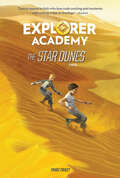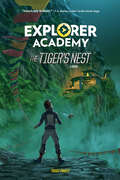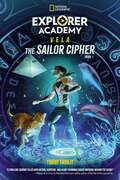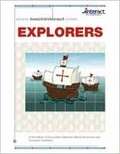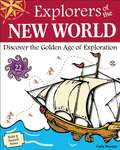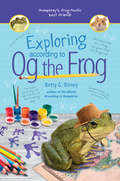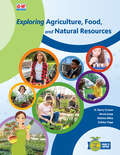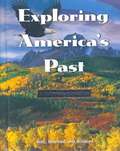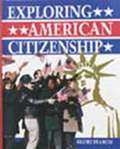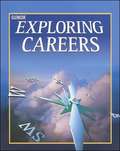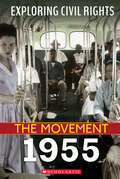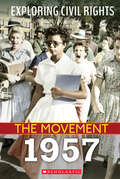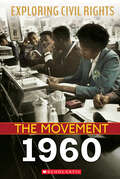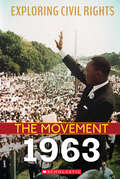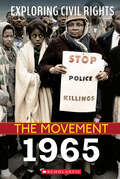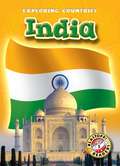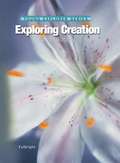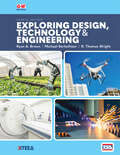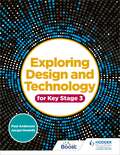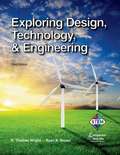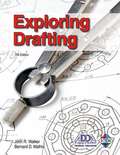- Table View
- List View
Explorer Academy: The Nebula Secret (Explorer Academy)
by Trudi TrueitAdventure, danger, and a thrilling global mission await 12-year-old Cruz Coronado as he joins an elite school for explorers.Cruz leaves his tranquil home in Hawaii to join 23 talented kids from around the globe to train at the Explorer Academy with the world's leading scientists to become the next generation of great explorers. But for Cruz, there's more at stake. No sooner has he arrived at the Academy than he discovers that his family has a mysterious past with the organization that could jeopardize his future. In the midst of codebreaking and cool classes, new friends and augmented reality expeditions, Cruz must tackle the biggest question of all: Who is out to get him, and why? Readers can get in on the excitement with puzzles and codes embedded throughout.
Explorer Academy: The Star Dunes (Explorer Academy)
by Trudi TrueitCruz, Sailor, Emmett, and the gang are on their way to Africa when Nebula misses their intended target and someone close to Cruz ends up on the brink of death. Secrets creep out from the shadows and leave Cruz with more questions than answers in this fourth title in the hit series.A major discovery forces the Explorer Academy into the limelight in The Star Dunes, but Cruz has much more on his mind than 15 minutes of fame. A new face on board the ship brings Cruz's worlds colliding, just as a major close call tears them apart. En route to Africa, Team Cousteau is now down a major player, and Cruz can't help but be preoccupied by the hole in his life. The discovery of his mom's next clue leads him to the most exotic location yet--a vast desert--with no other information to lead the way, while an unlikely ally helps Cruz pursue another piece of the puzzle. Just as things seem like they might turn out alright, Dr. Fanchon Quills has a technological breakthrough which gives Cruz a glimpse into the past and reveals more about his future than he may really want to know.
Explorer Academy: The Tiger's Nest (Book 5)
by Trudi TrueitCruz Coronado and his fellow explorers are jolted from their normal routines at Explorer Academy's classroom at sea and thrust into survival mode as the adventure continues in the fifth book in the thrilling middle-grade fiction series.On an island nation in the Indian Ocean, the explorers venture through a vast underwater world and take part in a friendly robotics competition. But the tides of good fortune change quickly. Suddenly, Team Cousteau jumps into action to rescue a faculty member from the brink of death. Meanwhile, the team follows the Cruz's mother's clues to a magnificent tomb and center of spirituality precariously perched on the side of a cliff. There, Cruz is confronted by a familiar foe who's determined to stop him from completing his most important mission of all: Retrieving the final pieces of his mother's cipher. In this life-or-death showdown, Cruz witnesses the ultimate sacrifice and uncovers a hidden message that makes him question his own mortality.
Explorers
by Margaret Todddetermined what students should learn, but also has mandated that students demonstrate what they know. EXPLORERS is a content-rich, standards-based program addressing National History Thinking Standards, American History Content Standards, Social Studies Standards, Theater Standards, and English Language Arts Standards. The content and skills presented in this unit are the targets of most state frameworks for American history, map reading, and language arts. EXPLORERS provides many opportunities for performance assessment. In the first part of the simulation students demonstrate their understanding of the Native American civilization that existed before the arrival of European explorers. In the second part, students learn the reasons why the explorers came to the New World. They research individual explorers to learn which lands and resources they claimed for their European monarchs. In the final activity, students participate in reenactments of the encounters between Native Americans and explorers. Applied Learning Standards are addressed throughout.
Explorers of the New World
by Tom Casteel Carla MooneyExplorers of the New World: Discover the Golden Age of Exploration offers a fascinating look at the explorers and their voyages during the Age of Exploration and Discovery. Readers ages 9-12 can delve into the expeditions of Vasco da Gama, Christopher Columbus, Ferdinand Magellan, John Cabot, Hernán Cortés, and more. Using common household items and minimal supervision, kids enjoy 22 hands-on activities to help them learn about these legendary explorers and their voyages. Discover how the adventures of a few people 500 years ago changed world history.Projects include creating and using a compass, learning to tie a sailor's knot, and baking and eating sea biscuits. Along with detailed, step-by-step instructions for each project, Explorers of the New World includes biographical sidebars, engaging illustrations, interesting facts, and vocabulary words that allow kids to experience this era in a fun, interactive way.
Exploring According to Og the Frog (Og the Frog #2)
by Betty G. BirneyIn the second book in the Og the Frog spinoff of the Humphrey series, Og is ready for adventure and is jumping at the chance to help kids be brave!Og loves the kids in Room 26, but he's awfully curious about the human world outside his tank! His friend Humphrey has no problem getting out and about, but it's harder for Og because he can't climb the way a hamster can. But Og never let hard work or fear stop him from going after what he wants. And he's determined to help the tads in Room 26 understand that taking risks can pay off--especially when they are being true to themselves. Whether it's learning that a younger kid can have great ideas, a student who learns differently can have hidden talents, or ideas that seem crazy at first can actually be amazing if you look at them from a different perspective, Og wants everyone to celebrate their talents. And once he fully embraces his frogginess--BING-BANG-BOING--he figures out how to go where no frog has gone before. Og's frog's-eye view of the world is curious, adventurous, and creative, and the perfect companion to Trouble According to Humphrey.
Exploring Agriculture, Food, and Natural Resources
by D. Barry Croom Kevin Jump Melissa Riley Ashley YoppExploring Agriculture, Food, and Natural Resources introduces middle school students to AFNR literacy to build excitement for the wide variety of opportunities in agricultural education and careers as they develop interpersonal skills, gain hands-on immersion in STEM, and begin planning a Supervised Agricultural Experience. Built to meet the needs of exploratory courses, seventy-six lessons are organized into twelve, flexible units that can be assigned to accommodate a variety of timeframes, interests, or grade levels. This text is expertly designed for young learners with engaging photographs narrated by colorful characters. Agriculture educator, Mrs. Lopez, introduces each lesson with reflective questions and connects students with ten additional, diverse characters spanning the agricultural career pathways. Students learn concepts in relation to how they may be used in a variety of careers from greenhouse manager to microbiologist, or national park ranger to supply chain specialist.
Exploring America's Past
by John A. GarratyAmerican beginnings (Beginnings-1763): Worlds meet; Empires in the Americas; The English colonies; Colonial life and government -- New American nation (1755-1801): Americans seek independence; Forming a new nation; Launching the United States -- Building a strong nation (1790-1860): Expansion and war; The North and manufacturing; The South and king cotton -- Seeking growth and change (1820-1860): Conflicts and reform; Americans expand west -- Division and reunification (1848-1900): Breaking apart; The Civil War; Reuniting the nation -- Rise of modern America (1850-1900): Western crossroads; Becoming an industrial nation -- America becomes a world power (1865-1920): Progressives and reform; Involvement in world affairs; America and the Great War -- Good times and world crises (1919-1945): A decade of change; The Great Depression; America and World War II -- Assuming global responsibilities (1945-1969): Returning to peace; Power and prosperity; Winds of change -- Modern America (1954-present): War in Southeast Asia; Searching for solutions; Republicans in power; The 1990s and beyond -- Reference section.
Exploring America, Part 1 (Columbus to Reconstruction)
by Ray NotgrassThis curriculum will guide you through the story of our country from the first European explorers to the present. We place great emphasis on original documents and speeches because these allow the participants in history to tell the story from their own perspective. This curriculum also introduces some of the great literature that Americans have produced: novels, short stories, autobiographies, memoirs, essays, poems, hymns, and other kinds of writing. The written and spoken word has a profound ability to move hearts and minds. This course also explores the significance of faith with regard to history. Faith is connected with history in two ways. First, people have often been motivated to act because of their faith in God. For instance, faith motivated the Pilgrims on the Mayflower to seek a new land in which to live. Faith caused people to oppose slavery. Faith has been expressed often in the speeches and documents that Americans have produced. We recognize and highlight the importance of faith throughout the American story. A second way that faith should be connected to history is by looking at the overall story of American history through the eyes of faith. We encourage students to think about the faith lessons that they can learn from people and events in history. For instance, many God-fearing Americans owned slaves and had a strong prejudice against blacks. We need to understand what caused those Christian people to be blinded by their culture and how they missed the example of Jesus and the teaching of Scripture about this issue (see John 4:7-9, Galatians 3:28, and Ephesians 2:19). This might help us realize cultural blindnesses we suffer today. A study of history can inform, challenge, and strengthen our own faith. "
Exploring America, Part 2 (Late 1800's to Present)
by Ray NotgrassThis curriculum will guide you through the story of our country from the first European explorers to the present. We place great emphasis on original documents and speeches because these allow the participants in history to tell the story from their own perspective. This curriculum also introduces some of the great literature that Americans have produced: novels, short stories, autobiographies, memoirs, essays, poems, hymns, and other kinds of writing. The written and spoken word has a profound ability to move hearts and minds. This course also explores the significance of faith with regard to history. Faith is connected with history in two ways. First, people have often been motivated to act because of their faith in God. For instance, faith motivated the Pilgrims on the Mayflower to seek a new land in which to live. Faith caused people to oppose slavery. Faith has been expressed often in the speeches and documents that Americans have produced. We recognize and highlight the importance of faith throughout the American story. A second way that faith should be connected to history is by looking at the overall story of American history through the eyes of faith. We encourage students to think about the faith lessons that they can learn from people and events in history. For instance, many God-fearing Americans owned slaves and had a strong prejudice against blacks. We need to understand what caused those Christian people to be blinded by their culture and how they missed the example of Jesus and the teaching of Scripture about this issue (see John 4:7-9, Galatians 3:28, and Ephesians 2:19). This might help us realize cultural blindnesses we suffer today. A study of history can inform, challenge, and strengthen our own faith. "
Exploring American Citizenship
by Globe FearonThe Student Texts and Student Workbooks provide helpful charts, tables, and maps that allow students to look closely at all critical aspects of U.S. government, including citizenship, the justice system, foreign policy, and much more. The book helps students understand the development of the government and the rights and laws of local, state, and federal governments.
Exploring American History
by John O'ConnorIn this book you will read the story of your country from its beginnings to the present day. The people who tell this story are called historians. You may wonder how historians find out what happened in the past. Historians are like detectives. They use many kinds of clues to learn about the way people lived and what they did in years gone by.
Exploring Careers (3rd Edition)
by Joan Kelly-Plate Ruth Volz-PattonThis completely revised middle school career education program, formerly titled Career Skills, motivates your students to investigate career opportunities they might pursue in the future.
Exploring Civil Rights: The Movement: 1955 (Exploring Civil Rights)
by Nel YomtovKey events of the Civil Rights Movement will be brought to life in this exciting and informative new series.The year 1955 saw a range of events that brought attention to the civil rights movement. In August, Emmett Till, a Black teenager, was brutally murdered in Mississippi. In December, Rosa Parks refused to give up her seat to a white man while riding on a bus in Alabama. Parks’ brave action resulted in the year-long Montgomery bus boycott, an event that brought transformational change to the city. These events and more sparked a movement that in the following years would bring Black youth to the forefront of much needed reform in the nation.The years from 1955 to 1965 are at the heart of the civil rights movement—from the Montgomery bus boycott to the Voting Rights Act. The contributions of key activists, including Rosa Parks, Dr. Martin Luther King Jr., John Lewis, Barbara Nash, and Malcolm X, are part of the narrative. Demonstrations of passive resistance and legal challenges were often met with bloodshed and violence against Black Americans fighting to end segregation and discrimination. Yet the courage of those yearning for equal opportunities under the law ultimately produced legislation affirming that every American should have the same constitutional rights, regardless of color, race, or gender.
Exploring Civil Rights: The Movement: 1957 (Exploring Civil Rights)
by Susan TaylorKey events of the Civil Rights Movement will be brought to life in this exciting and informative new series.1957 was a year of new beginnings and hope for a growing movement. In January, prominent civil rights leaders attended a historic meeting in Georgia with Dr. Martin Luther King Jr. at the helm. In September, as protests were heating up around the nation, a group of Black students, known as the Little Rock Nine, integrated Central High School in Little Rock, Arkansas. At the same time, activists’ push for legislation resulted in the passage of the Civil Rights Act of 1957. Progress toward equality for Blacks was slow, but people’s commitment to the movement continued to deepen by the year as the prospect of change seemed possible.The years from 1955 to 1965 are at the heart of the civil rights movement—from the Montgomery bus boycott to the Voting Rights Act. The contributions of key activists, including Rosa Parks, Dr. Martin Luther King Jr., John Lewis, Barbara Nash, and Malcolm X, are part of the narrative. Demonstrations of passive resistance and legal challenges were often met with bloodshed and violence against Black Americans fighting to end segregation and discrimination. Yet the courage of those yearning for equal opportunities under the law ultimately produced legislation affirming that every American should have the same constitutional rights, regardless of color, race, or gender.
Exploring Civil Rights: The Movement: 1960 (Exploring Civil Rights)
by Selene CastrovillaKey events of the Civil Rights Movement will be brought to life in this exciting and informative new series.The year 1960 was a turning point in the civil rights movement as young Black men and women became peaceful warriors for change. In February, four Black college students, known as the Greensboro Four, were refused service at a lunch counter in North Carolina. Their sit-in inspired similar protests across the country, demonstrating the ideals of civil disobedience and nonviolent resistance. In November, as the year drew to a close, the nation’s eyes were on Ruby Bridges, a Black first grader who bravely integrated the William Frantz Elementary School in New Orleans. Desegregation would create a crisis of law and order throughout the South as the decade continued.The years from 1955 to 1965 are at the heart of the civil rights movement—from the Montgomery bus boycott to the Voting Rights Act. The contributions of key activists, including Rosa Parks, Dr. Martin Luther King Jr., John Lewis, Barbara Nash, and Malcolm X, are part of the narrative. Demonstrations of passive resistance and legal challenges were often met with bloodshed and violence against Black Americans fighting to end segregation and discrimination. Yet the courage of those yearning for equal opportunities under the law ultimately produced legislation affirming that every American should have the same constitutional rights, regardless of color, race, or gender.
Exploring Civil Rights: The Movement: 1963 (Exploring Civil Rights)
by Angela ShantéKey events of the Civil Rights Movement will be brought to life in this exciting and informative new series.The year 1963 brought both violence and a speech that resonates today. In June, two Black students were blocked from registering for classes at the University of Alabama. Civil rights leaders responded with a historic protest. In August, 250,000 people gathered for the March on Washington as Dr. Martin Luther King Jr. delivered his “I Have a Dream” speech. The following month, a bomb planted by the Ku Klux Klan killed four girls at a church in Alabama. The extent of racism and discrimination was finally laid bare, as public sentiment for the movement swelled and change now seemed inevitable.The years from 1955 to 1965 are at the heart of the civil rights movement—from the Montgomery bus boycott to the Voting Rights Act. The contributions of key activists, including Rosa Parks, Dr. Martin Luther King Jr., John Lewis, Barbara Nash, and Malcolm X, are part of the narrative. Demonstrations of passive resistance and legal challenges were often met with bloodshed and violence against Black Americans fighting to end segregation and discrimination. Yet the courage of those yearning for equal opportunities under the law ultimately produced legislation affirming that every American should have the same constitutional rights, regardless of color, race, or gender.
Exploring Civil Rights: The Movement: 1965 (Exploring Civil Rights)
by Jay LeslieKey events of the Civil Rights Movement will be brought to life in this exciting and informative new series.The civil rights movement in 1965 was fraught with assassination, brutal attacks, and an attempt to deny Black Americans the right to vote. In February, Malcolm X, a Black religious leader and human rights activist, was slain. Bloody Sunday followed in March when 600 civil rights protesters attempted to walk from Selma to Montgomery, the capital of Alabama, to oppose the suppression of the Black vote. As a result, the Voting Rights Act of 1965 was ultimately signed into law in August. The civil rights movement succeeded in getting legislation passed, but the fight against racism, discrimination, and hatred was far from over.The years from 1955 to 1965 are at the heart of the civil rights movement—from the Montgomery bus boycott to the Voting Rights Act. The contributions of key activists, including Rosa Parks, Dr. Martin Luther King Jr., John Lewis, Barbara Nash, and Malcolm X, are part of the narrative. Demonstrations of passive resistance and legal challenges were often met with bloodshed and violence against Black Americans fighting to end segregation and discrimination. Yet the courage of those yearning for equal opportunities under the law ultimately produced legislation affirming that every American should have the same constitutional rights, regardless of color, race, or gender.
Exploring Countries India
by Jim BartellDeveloped by literacy experts for students in grades three through seven, this book introduces young readers to the geography and culture of India.
Exploring Creation with Botany
by Jay L. Wile Jeannie FulbrightThe book is written directly to the student, making it appealing to kids. Presenting science concepts in a conversational, engaging style makes science enchanting and memorable for your students. It also fosters a love for learning. This course is written for children between six and twelve years old. When the course is complete, this book will serve as an excellent reference for your family's future questions and studies in botany. As a result, this book is a life-long investment!
Exploring Design Technology and Engineering
by R. Thomas Wright Ryan A. Brown Michael BerkeihiserIntroduction to Anatomy and Physiology covers all body systems using a student-friendly writing style that makes complex subjects easier to understand. Written specifically for the high school market, the chapters in this textbook are divided into lessons, providing content in a manageable format for the student. Each lesson is further divided into subtopics, with questions at the end of each subtopic to help students gauge their understanding of the material. Clinical case studies and real-world applications enhance student interest and involvement. An outstanding illustration program includes anatomically exact drawings with great use of color, simplified labeling, and teaching captions. Strong pedagogy includes study aids, such as learning objectives, lesson summaries, and extensive assessment opportunities increase students’ ability to succeed in this challenging course. This edition has been updated to include content on the impact of COVID-19, artificial tissues, muscle disorders, the sense of touch, and Rh factor to the universal donor and universal recipient definitions.
Exploring Design and Technology for Key Stage 3
by Paul Anderson Jacqui HowellsDevelop knowledge, understanding and designing and making skills through Key Stage 3 so students are ready for the new GCSE in Design and Technology, with our brand-new Student Book.With topics directly linked to the new GCSE (9-1) specifications, Exploring Design and Technology will build a solid foundation by boosting your students' understanding of the key concepts, introducing them to important terminology and developing their practical skills through Key Stage 3.· Build understanding through years 7, 8 and 9 with engaging, carefully timed and level-appropriate lessons that draw on the GCSE subject content.· Develop practical skills with a variety of creative designing and making activities that use a wide range of materials, tools, equipment and processes. · Boost knowledge with clear explanations of important terminology and concepts that students will need to apply when identifying design problems, understanding user needs and developing design solutions in a range of contexts.· Encourage subject interest with 'find out more' - research features that broaden understanding of materials and their working properties, new technologies and the wider influences on designing and making.· Monitor and measure student progress with knowledge check questions provided for every topic.
Exploring Design, Technology, & Engineering
by R. Thomas Wright Ryan A. BrownExploring Design, Technology, and Engineering is an exciting introductory technology education text that provides in-depth coverage of the content defined in the Standards for Technological Literacy. Coverage includes the impacts of technology, technological systems, the history of technology,applying technology, and the designed world (agriculture and biotechnology, construction, manufacturing, information and communication, transportation, energy and power, and medical technology). This edition includes updated information o job skills, technological needs and wants, and technologicalimpacts.
Exploring Drafting
by John R. Walker Bernard D. MathisExploring Drafting is designed for use in introductory drafting courses at any instructional level. This text provides a strong foundation in drafting fundamentals and teaches essential manual (traditional) and CAD drafting skills. Coverage includes detailed instruction on geometric constructions, orthographic projection, and dimensioning practices. The text covers techniques and procedures used in creating multiview drawings, section views, auxiliary views, pictorial views, and pattern developments. End-of-chapter drawing problems reinforce the chapter content and help students build problem-solving skills. Exploring Drafting features a colorful, highly illustrated design to promote student interest.

